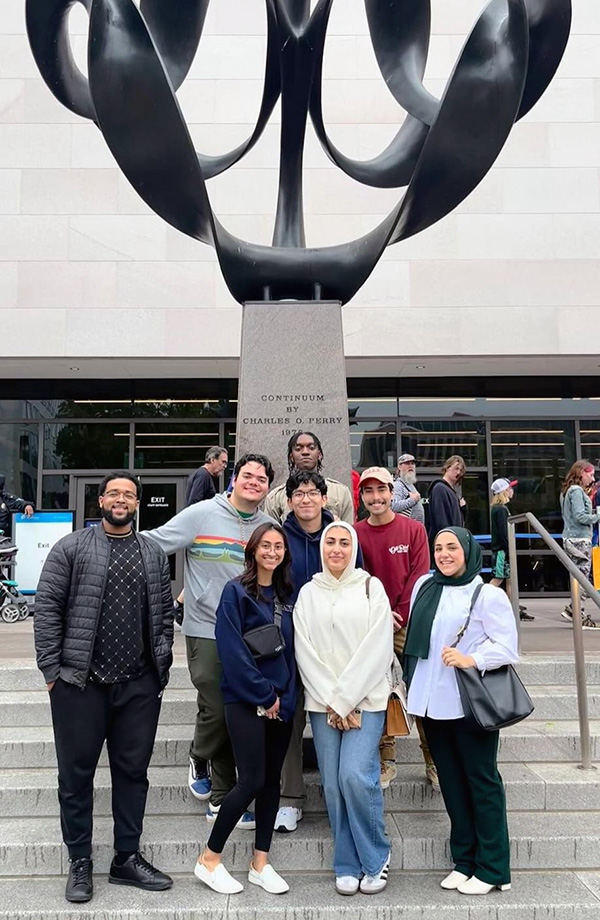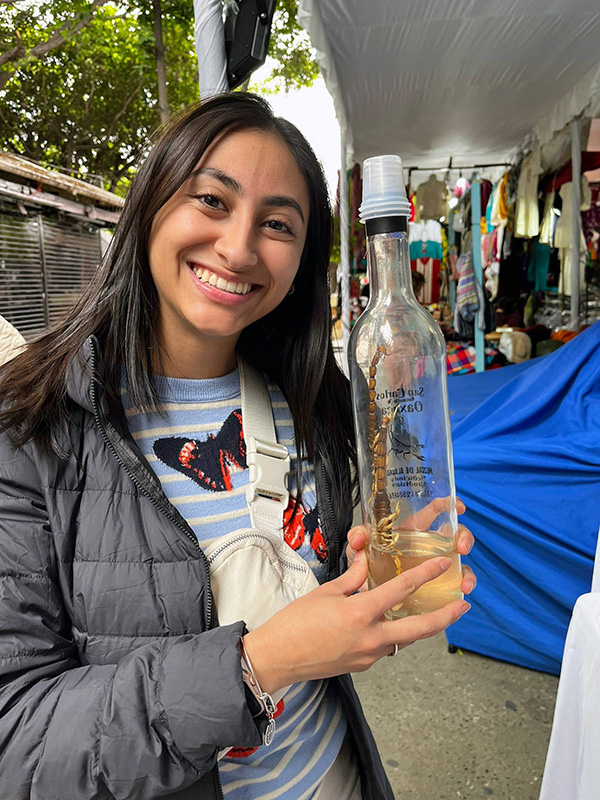First-generation college student, NASA contest winner and aspiring astronaut Chelsea Garcia is driven by family and heritage

Chelsea Garcia's journey is one of perseverance in pursuit of her dreams. Eager to become an astronaut, she arrived in AAE for the Fall 2024 semester fresh from a major success: She led a team that nurtured her idea into a winning proposal in the NASA Proposal Writing and Evaluation Experience Academy. The team earned $10,000 in funding to continue exploring the constructive use of regolith for in-situ engineering in space.
With that project in her back pocket, she was ready to pursue a master's degree in aeronautical and astronautical engineering under distinguished professor R. Byron Pipes, a legend in the world of aerospace composites.
In the Q&A below, Garcia shares the importance of composite materials to aerospace engineering, the personal significance of her Hispanic heritage, and how her mother inspires her persistence.
Delve into Chelsea's experiences, insights, and the driving forces behind her remarkable journey.
Why did you choose Purdue for your master's degree, and why aerospace engineering?
Purdue has always been my dream school. Around my Junior year of high school, I got really into astronomy, space, engineering, and the process of becoming an astronaut. I remember watching a tour video of a NASA facility and the woman in charge was a Purdue alumna. Several other videos I have watched also mentioned Purdue alumni, so I did my research. I found out it was one of the top schools for aerospace engineering and even considered a "cradle of astronauts."

The campus, culture and academics are what drew me to Purdue. Although I attended New Jersey Institute of Technology for my bachelor's, Purdue was my top choice for aerospace engineering.
I always bounced around with what I wanted to do with my life. I went from doctor to photographer, to interior designer, to architect, and even came close to switching my major during my sophomore year of college from mechanical to civil engineering because mechanical was "too hard."
It was a combination of my high school astronomy club teacher, Dr. Necoechea, and the movie "The Martian" that drove me to want to pursue a career in aerospace. The Martian inspired me deeply by showcasing how brilliant minds from diverse fields came together to solve complex problems. The idea of collaborating with such a dedicated team, and contributing to something larger than myself, sparked my desire to pursue a career to ultimately become an astronaut.
Being part of a mission or project where every individual plays a crucial role in advancing humanity's understanding of space is exactly what I aspire to achieve. Looking back, I am so glad I didn't give up and switch my major because it was "too hard". Now I am at one of the top schools for aerospace engineering and can continue working towards my dream of becoming an astronaut.
What are you studying in Prof. Byron Pipes' research group?
In Dr. Pipes' research group, my focus is on manufacturing and composites, particularly in aerospace applications. Although I haven't received an official thesis topic yet, I chose to work with Dr. Pipes because of his extensive expertise in advanced composite materials, which are critical for enhancing the performance and efficiency of aircraft and spacecraft. His work in this field offers an exciting opportunity to explore innovative approaches to material science, specifically how we can optimize the properties of composites to meet the stringent demands of the aerospace industry.
Why is this an important field for you?
Composites are important for innovation in the aerospace industry. The ability to create materials that are both lightweight and incredibly strong opens the door to designing more efficient aircraft and spacecraft. In an industry where performance, safety, and sustainability are critical, optimizing the properties of composites allows us to push the limits of what aerospace technology can achieve.

On a personal level, working with composites combines my passion for problem-solving with a tangible impact on the future of space exploration and aviation. It's inspiring to know that my research could contribute to the development of materials that help reduce fuel consumption, extend the lifespan of aircraft, or even enable more ambitious space missions. This aligns with my desire to be part of a team that advances scientific and technological frontiers.
Does your research here have anything to do with your proposal this summer in the NASA PWEE academy?
My NASA NPWEE project works with resin and additive manufacturing (3D printing) which is something my lab specializes in. However, it is totally unrelated to my research and is something I work on outside of my academic work at Purdue. I work on this project virtually with my teammates.
How did you feel when your team won at the academy and earned funding to dig deeper on your idea?
I vividly remember texting my teammates as the results were being announced. We were all on edge, anxiously waiting to see how we did. When the top seven teams were called, and we saw our team number among them, we were so happy. Even if we didn't win, just making it that far felt like a huge accomplishment.
But then came the announcement for the winners, and when I saw our team number on the screen, my jaw dropped—I was in complete shock. We knew we had put so much time and effort into every detail of the project, but seeing that all of our hard work had paid off in such a big way felt absolutely surreal.
It was an overwhelming moment of pride, joy, and disbelief all at once. I am so thankful that we got the opportunity to dig deeper into the topic of in-space manufacturing and knowing that if our project is a success, we could potentially help astronauts 3D print tools in space!
Can you give a bit of detail on your Hispanic heritage?
My family is deeply rooted in Mexico. My parents are both from the state of Jalisco, but my mom is from the city of Juanacatlan and my dad is from Guadalajara. A lot of my family has moved to the US around the same time as my parents, but I am in the first generation of my family to be born in the U.S.

I visited Mexico for the first time in December 2023. It was so surreal to finally meet family members I had only seen through video calls.
Experiencing the culture firsthand was also something that put a lot of things into perspective for me. I realized how fortunate I was that my parents kept so much of the Mexican culture alive at home. The food, traditions, and language are all components that I hold so important to me so I try and keep them alive even when I'm not at home with them.
Is it meaningful for you to be a Hispanic woman working in this research field?
Absolutely. Coming from a Hispanic background where my parents never attended college makes doing a master's more challenging. No one in my family has a master's degree or research experience so I can't ask my parents for advice on how to handle college-specific issues or questions. These are all things that I've had to take the initiative to figure out for myself.
Similarly to many Hispanics I've met, across generations on both sides of my family, there's a persistent cycle of missed educational opportunities due to reasons out of their control. This pattern creates a loop where they are unable to pursue or capitalize on educational possibilities. Working not only in this research field but in the aerospace industry is a commitment to breaking generational cycles.
My experiences as a Hispanic woman in engineering fuel my commitment to fostering inclusivity, especially in academia. There were times during my undergrad that I would be the only girl in my class — much less a Hispanic woman.
Instead of letting that intimidate me, I embrace it, and it makes me proud that I can represent my heritage. Eventually, I would like to be an example for any person who has been in my shoes to know that it is possible to achieve your goals and hopefully motivate them to follow in my footsteps of pursuing a STEM degree.

Was there a particular person that you looked up to or inspired you to pursue work in aerospace?
The most significant pillar of support in my life has been my mother. When I was in high school, she may not have fully grasped the intricacies of the scientific discussions I tried to have with her, but every time I shared my passion with her, she always shared the same excitement I had whenever I was learning something new.
Her belief in me and her enthusiasm have been the motivation to pursue my dream of working in aerospace and becoming an astronaut. She never made me feel like my dreams were too ambitious or out of reach. Whenever I did feel that way, she would always tell me to not be afraid to take an opportunity just because it was going to be "too hard" and that it is our passion and determination to reach our goals that can shape our success.
My mother, whose education was cut short, understands the frustration of not being able to reach her full potential so she always pushed me to reach mine. It was during those heartfelt conversations with my mother that I realized the boundless potential of education and how important it is to follow my dreams.
Where do you hope your career will take you next?
After grad school, I want to work for companies that focus on research and development in structures and materials for space or aviation applications. I'm passionate about contributing to projects that have real-world impact, whether through collaborations with industry or working on space exploration missions.
My ultimate dream would be to work towards becoming an astronaut or being involved in projects that benefit astronauts as they return to the moon or explore Mars. Being part of a team that directly impacts space exploration would be incredibly fulfilling for me.
